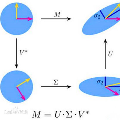This work proposes to reduce visibility data volume using a baseline-dependent lossy compression technique that preserves smearing at the edges of the field-of-view. We exploit the relation of the rank of a matrix and the fact that a low-rank approximation can describe the raw visibility data as a sum of basic components where each basic component corresponds to a specific Fourier component of the sky distribution. As such, the entire visibility data is represented as a collection of data matrices from baselines, instead of a single tensor. The proposed methods are formulated as follows: provided a large dataset of the entire visibility data; the first algorithm, named $simple~SVD$ projects the data into a regular sampling space of rank$-r$ data matrices. In this space, the data for all the baselines has the same rank, which makes the compression factor equal across all baselines. The second algorithm, named $BDSVD$ projects the data into an irregular sampling space of rank$-r_{pq}$ data matrices. The subscript $pq$ indicates that the rank of the data matrix varies across baselines $pq$, which makes the compression factor baseline-dependent. MeerKAT and the European Very Long Baseline Interferometry Network are used as reference telescopes to evaluate and compare the performance of the proposed methods against traditional methods, such as traditional averaging and baseline-dependent averaging (BDA). For the same spatial resolution threshold, both $simple~SVD$ and $BDSVD$ show effective compression by two-orders of magnitude higher than traditional averaging and BDA. At the same space-saving rate, there is no decrease in spatial resolution and there is a reduction in the noise variance in the data which improves the S/N to over $1.5$ dB at the edges of the field-of-view.
翻译:----
本文提出了一种基于基线的有损压缩技术,可以减小可见性数据的体积,同时保留视场边缘的模糊。我们利用矩阵秩与低秩近似的关系,将原始可见性数据描述为特定傅里叶分量的基本部位之和的形式。因此,整个可见性数据从基线的角度表示出来,而不是作为单个张量。我们提出了两种方法。第一个方法名为简单SVD,将数据投影到秩为-r的数据矩阵的定期抽样空间中。在该空间中,所有基线的数据具有相同的秩,这使得基线之间的压缩因子相等。第二个方法名为BDSVD,将数据投影到秩-rpq的数据矩阵的不规则采样空间中。下标pq表示数据矩阵的秩会因基线pq而变化,这使得压缩因子依赖于基线。使用MeerKAT和欧洲极长基线干涉望远镜网络作为参考望远镜,评估并比较了所提出方法与传统方法(如传统平均和基线相关平均)的性能。对于相同的空间分辨率阈值,简单SVD和BDSVD都显示出比传统平均和基线相关平均高两个数量级的有效压缩。在相同的空间节约率下,没有降低空间分辨率,并且数据的噪声方差降低,提高了边缘视场的信噪比至少1.5 dB。

